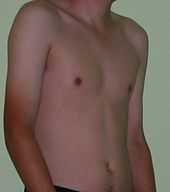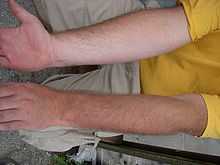Tan line

Tan lines refers to a division between an area or areas on the skin of a human of pronounced comparative paleness relative to other areas of their body that have been suntanned by prolonged exposure to ultraviolet radiation. The source of the radiation may be the sun, or artificial UV sources as used in tanning beds. The tanned area is such that it becomes visually clear where the body of the person was exposed versus the place(s) they covered up. Tan-line areas can occur more generally in almost any context where the human body is exposed to comparatively more sunlight in certain areas than in others. In some cases very little sunlight is required: people can sometimes pale even further than the natural skin tone of the rest of their body.[citation needed] In women, paling further than natural skin tone sometimes occurs in the areas of the breasts typically covered by the brassiere or a bathing suit top. Paling can also occur due to coverage around the buttocks or groin area where clothes are especially taut. Tan lines are usually an inadvertent result of a work environment or of recreational activities, but are sometimes a personal choice.
Occupation-related tan lines

Farmer's tan
A farmer's tan is the tan lines developed by a working farmer regularly exposed to the sun.[1] The farmer's tan is usually started with a sun tan covering only the arms and neck. It is distinct in that the shoulders, chest, and back remain unaffected by the sun. Similar tan lines include the "Texas tan", which is very similar, with the exception that the shoulders are also affected by the sun. The Texas tan is caused by working in the sun while wearing a muscle shirt or an A-shirt.
Some of the common tan lines associated with a farmer's tan include:
- forearms (from a short-sleeve shirt or t-shirt)
- neck (from shirt collar)
- thighs (if shorts are worn)
- ankles (from socks, only if exposed)
- forehead (if a hat is worn)
- wrist (if a watch is worn)
- sunglasses tan line
Trucker's tan
A "trucker's tan" is a variation of the farmer's tan where one arm from the sleeve downward is tanned significantly more than the other arm due to driving with the windows down. While named a "trucker's tan," such a tan line is not exclusive to truck drivers and can be attained by driving most motor vehicles. An "inverted trucker's tan" is when the passenger in a vehicle has similar tan lines as a trucker's tan, but on the opposite arm.
In Britain, this tan is sometimes known as a "white van-man tan", since people in professions such as building, plastering, or plumbing tend to have this tan, and a "white van" is their most commonly used vehicle.
Taxi driver's arm
In the United Kingdom "trucker's tan" is known as "taxi driver's arm" and is exclusively, since driving on the left, the right arm which rests on the open window.
Franciscan tan
A "Franciscan tan" is a tan that is associated to the Franciscan order. The reason behind this is that Franciscans usually wear sandals during the summer. This creates an odd tan line when the sandals are off because, depending on the sandal, the feet will have a tan line.
Recreation-related tan lines
Driver's tan
A driver's tan is associated with extensive driving while hanging one arm out the window.
Biker's tan

Other recreation-related tan lines
- "Goggle tan"
- "Tennis tan"
- "Racing stripes" - the portion of a bikini tan line exposed when wearing one-piece swimwear.
- "Soccer tan" - a stripe of tan from the lower thighs to the bottom of the knees common to soccer players; the upper thighs and lower legs are covered by shorts and shin guards/socks.
- "Football tan" - a stripe of tan from below the knees to just above the ankle; the thighs, knees and ankles are covered by uniform pants and ankle socks. Often the arms are tanned similarly to a farmer's tan, but the face is untanned due to wearing a helmet. This tanning effect can be particular pronounced since many football teams run two-a-day practices during the summer.
- "Tiger tan" - two tan stripes on the arm of a lacrosse player, resulting from the gap between gloves and elbow pads, and the gap between elbow pads and shoulder pads.
Intentional tan lines
One of the common uses for tanning beds is to reduce the appearance of tan lines. Because an individual has the option of tanning completely nude in a tanning bed, and most public areas do not allow nude tanning, it has been seen as an alternative for those who are actually seeking a tan.[citation needed] In contrast, some people prefer to have tan lines, and will wear undergarments or swim wear in a tanning bed or outside for the sole purpose of creating a sharply defined tan line.
Additionally, tanning stickers can be purchased that are simply stickers that attach to your skin while tanning. Common designs are a heart, Playboy bunny and dolphins, but many different designs exist. These are typically sold on a roll of 500 to 1000 as single use, disposable sticks. People can place the sticker on the same area each time they tan (indoors or outdoors) and this will leave the covered area pale, while the rest of their skin tans normally. This allows the individual to see their tanning progress, and allows others to see as well if the tan tattoo is used in an exposed place.[2]
It is also possible to use sunscreen to intentionally create tan lines that form patterns or words, to make a statement or simply create a design.
Avoiding tan lines
The wearing of clothing while tanning results in creation of tan lines, which many people regard as un-aesthetic and embarrassing. Many people desire to avoid creation of tan lines on those parts of the body which will be visible when they are fully clothed. Some people try to achieve an all-over tan or to maximize their tan coverage. To achieve an all-over tan, the tanner needs to dispense with clothing; and to maximize covering, they need to minimize the amount of clothing they wear while tanning. For those women who cannot dispense with a swimsuit, they at times tan with the back strap undone while lying on the front, or removing shoulder straps, besides wearing swimsuits which cover less area than their normal clothing. Any exposure is subject to local community standards and personal choice. Some people tan in the privacy of their backyard where they can at times tan without clothes, and some countries have set aside clothing-optional swimming areas (also known as nude beaches), where people can tan and swim clothes-free. Some people tan topless, and others wear very brief swimwear, such as a microkini. A recent innovation is tan-through swimwear, which uses fabric which is perforated with thousands of micro holes that are nearly invisible to the naked eye, but which let enough sunlight through to produce a line-free tan. Tan-through swimsuits offer SPF protection of about 6, and an application of full-strength sunscreen even to the covered area is recommended.
Because of the potential sunburn which can result from excessive exposure to direct sunlight, many people suntan in moderation and wear some clothing, including a hat, and use suitable sunscreen. From time to time they also sit in the shade or cool off in water.
See also
-
 Media related to Tan lines at Wikimedia Commons
Media related to Tan lines at Wikimedia Commons - Sun tanning
References
- ↑ "Tan". C95. Retrieved June 3, 2012.
- ↑ "How to Get a Tan Tattoo". wikiHow. Retrieved June 3, 2012.